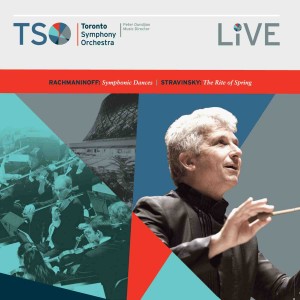Rachmaninoff’s Symphonic Dances
Stravinsky’s The Rite of Spring
Recorded live at Roy Thomson Hall
The Toronto Symphony Orchestra (TSO) and Music Director Peter Oundjian has released a recording of Igor Stravinsky’s The Rite of Spring—in commemoration of the 100th anniversary of the work—and Sergei Rachmaninoff’s Symphonic Dances on the Orchestra’s self-produced recording label, TSO LIVE.
The Toronto Symphony Orchestra and TSO Music Director Peter Oundjian’s performance of Stravinsky’s The Rite of Spring was recorded live in December 2008, and Rachmaninoff’s Symphonic Dances in May 2012. Both performances were recorded at Roy Thomson Hall in Toronto. This is the Orchestra’s eighth release in its series of recordings on the TSO LIVE label.
The recording is available for download at TSO.CA/tsolive, iTunes and amazon.com. The CD will also be available at the Roy Thomson Hall music store.
Igor Stravinsky’s iconic work, The Rite of Spring, premièred in Paris on May 29, 1913 by Sergei Diaghilev’s Ballet Russes to famous protest and pandemonium. The auditorium was in an uproar, with the production’s supporters and detractors clamouring to make their feelings known about Stravinsky’s ground-breaking score and Vaslav Nijinsky’s novel choreography. Overnight, The Rite of Spring transformed perceptions of Stravinsky from a talented follower of Rimsky-Korsakov and Debussy to the ranks of such “wild men” of twentieth-century music as Bartók and Schoenberg.
“Sometimes we forget that all music was new music when it was first heard, and lose our curiosity with new works, but we must remind ourselves that some of the most popular music in the orchestral repertoire seemed strange to the audiences of the day,” said Oundjian in his introduction to the 2008 programme.
The ability of Stravinsky’s propulsive score—best known now as a concert piece—to astonish and electrify remains undiminished a century after it first took the world by storm.
Sergei Rachmaninoff, pianist, composer, and one of the last great artists of Russian Romanticism in classical music, composed Symphonic Dances in 1940, not long before his death in 1943. This work is fully representative of the composer’s late style.
The driving first movement unfolds with a grim determined march. The second movement is a heavily stylized parody of the Viennese waltz, both nostalgic and sarcastic. The finale, the most fantastical dance, is full of demonic energy. Throughout the piece, Rachmaninoff quotes from his own works and a favourite source of inspiration, Russian Orthodox chant, the meanings of which appear to be private. “I thank thee, Lord,” Rachmaninoff wrote, at the end of his score. Sadly prophetic words as Symphonic Dances was his last composition.
In his review of the 2012 performance, John Terauds of the Toronto Star noted how “Oundjian shaped the music elegantly, giving it soft contours and teasing out gorgeous, burnished sounds from the orchestra. This was a kinder, gentler Rachmaninoff, in line with the overall theme of a golden musical evening.”
In particular, “Rachmaninoff’s final dance was a model of clarity,” stated Arthur Kaptainis in the National Post review, “balances and blends were superbly gauged and intonation was spot on.”

